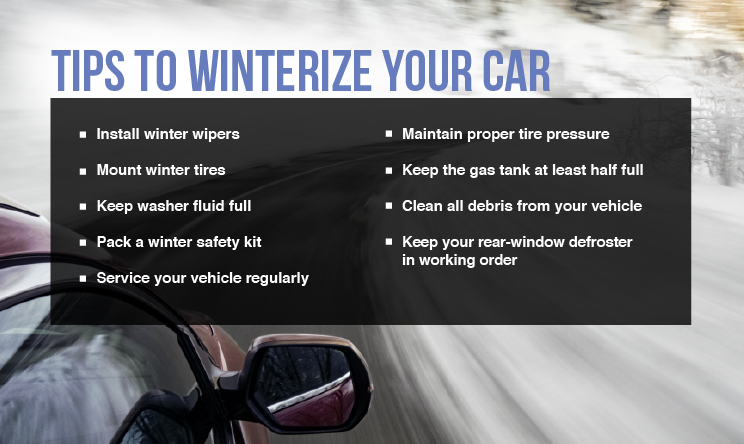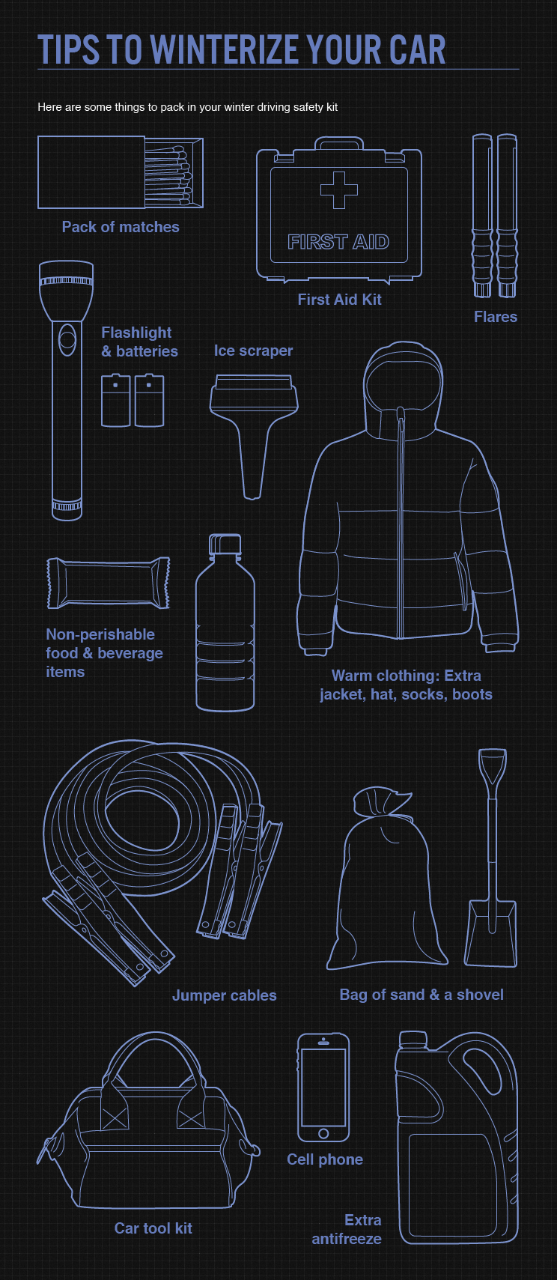TIPS FOR WINTERIZING YOUR CAR
Winter driving conditions can be hazardous due to factors such as snow and ice on the road. While it’s important that you are prepared for winter driving, it is also important that your car is up for the challenge. It is recommended that you winterize your car before the winter season to make sure your car can handle the winter road conditions.

1. Install winter wipers
These come equipped with rubber that keeps ice from collecting on the blades. Just be sure to remove them when spring rolls around. As winter wipers are heavier than regular ones, keeping them on all the time increases the risk of burning the motor out too soon.
2. Mount winter tires
If you live in a place that experiences extreme cold winter temperatures, it is recommended that you install winter tires when winterizing your car. When the temperature consistently hovers around or below freezing, the rubber compounds in non-winter tires harden, decreasing the tire’s ability to grip the road. Winter tires use special compounds engineered to resist hardening in cold temperatures, providing better traction.
You should definitely have snow tires installed with plenty of time to spare before extreme winter weather arrives. We say, if you can see your breath, it’s time to install winter tires.
Learn more about Blizzak winter tires.
If you plan to drive in snowy conditions, it is suggested that you keep chains handy and know how to install them. If you live somewhere where chains are required, keeping a set on hand is a must.
3. Keep washer fluid full
When driving in snow and ice, you may use a lot of washer fluid in an effort to keep your windshield clean. In order to properly winterize your car, maintain a nearly full washer fluid reservoir and consider keeping a spare bottle or two in the trunk.
4. Pack a winter safety kit

In the event of an emergency, you’ll be glad you kept supplies on hand. Here are some things to pack in your winter driving safety kit:
- Ice scraper
- Bag of sand and a shovel
- Cell phone
- Flares
- First aid kit
- Extra antifreeze
- Flashlight and batteries
- Car tool kit
- Jumper cables
- Warm clothing: Extra jacket, hat, socks, boots
- Non-perishable food and beverage items
- Pack of matches
5. Service your vehicle regularly
Perhaps the most important precaution for safe winter driving – and one that many winterizing a car lists overlook – is servicing your vehicle. If you’re not doing it regularly, be sure to do it as soon as there’s a chill in the air.
Belts and hoses, spark plugs, wires and cables: these can go bad at any time of year, but if they go bad during the winter, you could be stranded in a very cold place for a very long time – and that could be dangerous.
When you get your vehicle serviced, be sure the technician checks the following:
- Battery and charging system
- Antifreeze and cooling system
Just because your battery works fine now doesn’t mean it will in sub-freezing temperatures. Cars can be harder to start in the winter and may need a powerful, high-performing battery. A good battery for winter driving will bear the 600 CCA (cold cranking amps) rating. It is recommended that your auto care provider can install a battery at or above 600 CCA for optimal winter performance.
As for the cooling system, it is recommended to maintain a ratio between 50/50 and 70/30 of antifreeze to water. You can always use the well-known, green-colored antifreeze, but some engines also take a newer, longer-lasting coolant that may or may not be green in color. Ask your technician which is best for your engine. Also confirm the appropriate coolant to water ratio for your situation.
6. Maintain proper tire pressure
Every 10 degree change in ambient temperature could mean a gain or loss of 1 PSI. This means you should check pressure more regularly during winter and refill your tires as needed. Appropriate pressure for your tires can be found on the tire placard in the driver’s side door jamb or in your vehicle owner’s manual.
7. Keep the gas tank at least half full
Fill up often! Keeping gas in the tank is more important in winter than in summer. Why? For one thing, a full tank can help prevent gas line freeze ups. Not only that, but if you’re ever stranded, your engine may be the only thing to keep you warm until help arrives.
8. Keep your rear-window defroster in working order
Being unable to see behind you could create unsafe driving conditions. That’s why several states have laws stating that all your windows must be clear of condensation and debris. When winterizing your car, check your rear-window defroster before cold weather arrives to be sure it’s working properly.
What to Do Before You Drive
Before you get behind the wheel, it’s important to remove all snow and ice from the windshields, windows, tops, and sides of your vehicle – yes, all of it! There are two reasons for this: removing debris from all windows and the roof improves visibility, and prevents chunks of it from falling off and hitting other cars.
In addition, remember these things before getting behind the wheel in winter:
- Allow enough time to get where you need to go safely.
- Slow down!
- Allow more stopping distance. Snow and ice make it more difficult to stop. Allow more space between your vehicle and the vehicle ahead of you.
- Watch the weather. Be aware of any trecherous weather that may be headed to your area.
If the roads are just too dangerous, don't risk an accident!
-
Drive into Summer Prepared
Drive into Summer Prepared
There's more to driving in the summertime than just cranking up the A/C. Heat can be your car's worst enemy, so make sure your ride is ready for the road, no matter what the summer brings.
Learn More -
10 Driving Tips for New Drivers
10 Driving Tips for New Drivers
Getting your first driver's license is an exciting step toward independence and adulthood, but it's also a big responsibility. Learn how to balance this new freedom with caution and safe behavior.
Click to Learn More -
Driving Safely in Wet Conditions
Driving Safely in Wet Conditions
Slick roads and reduced visibility can make driving dangerous. Do you know what to do to stay safe driving in rainy weather?
Click to Learn More